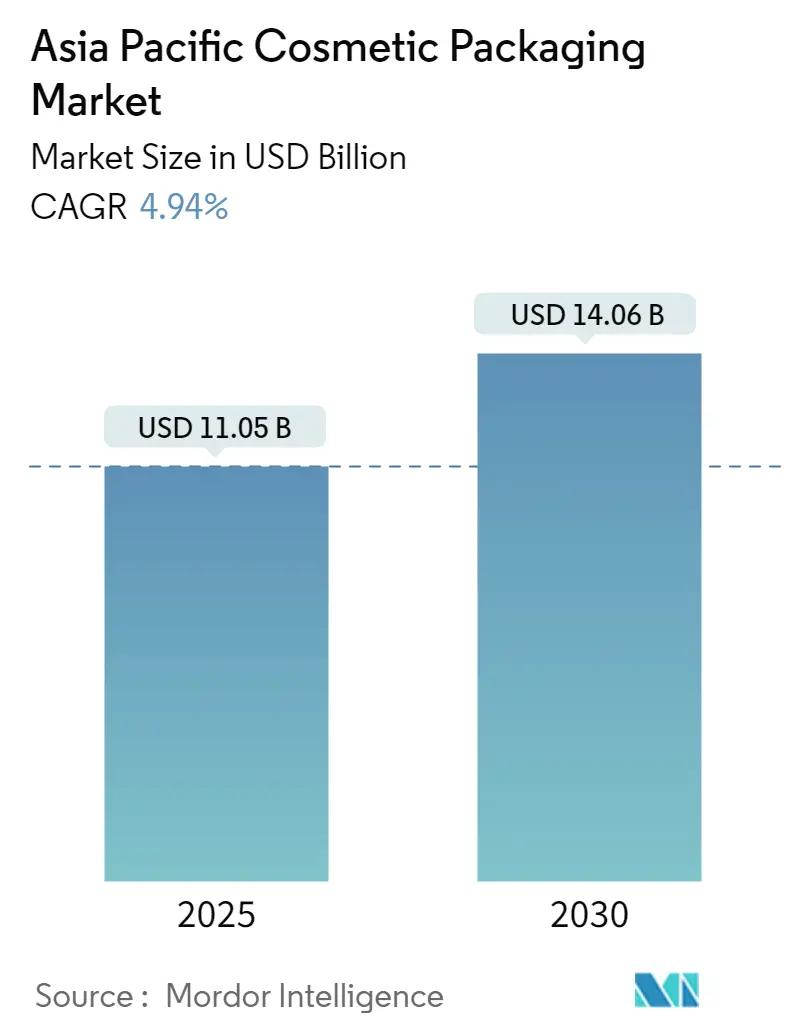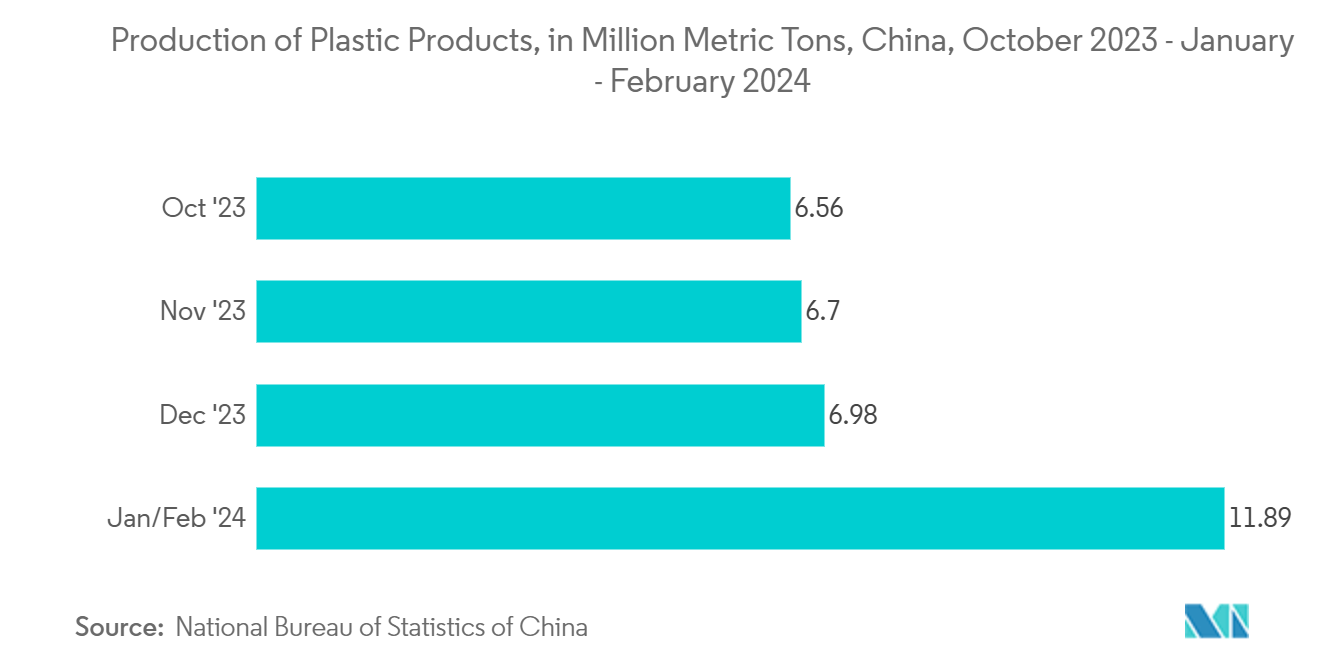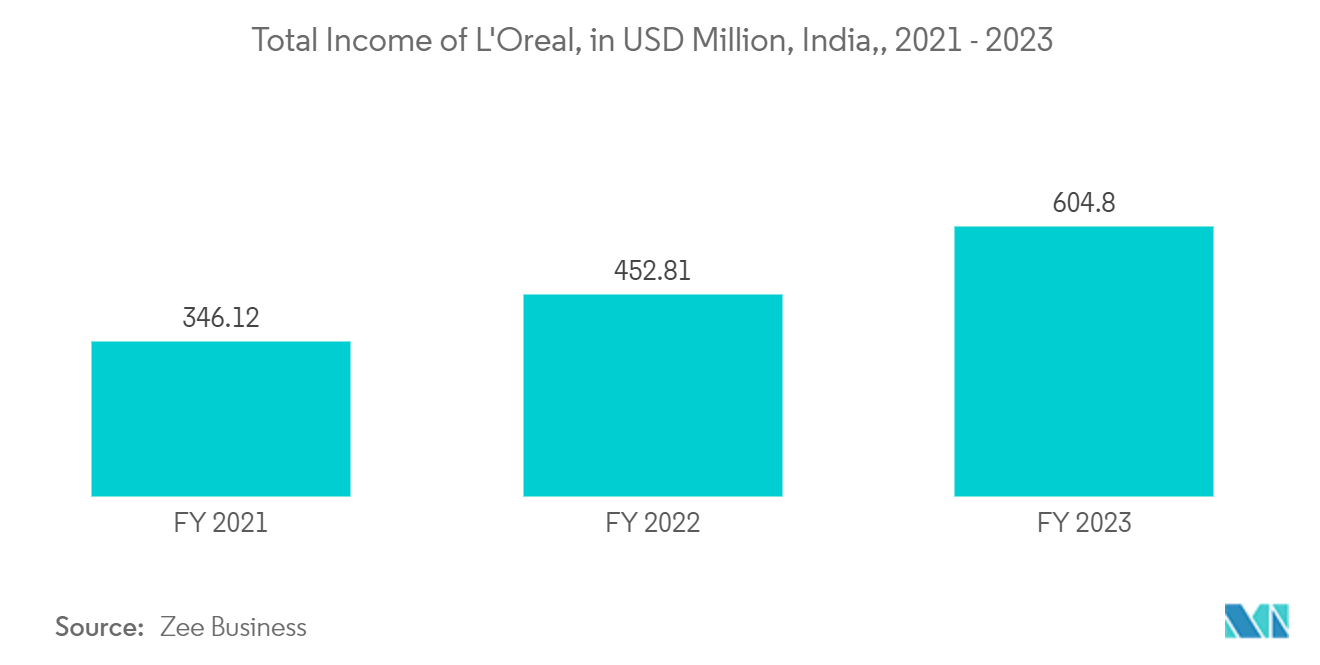
Asia Pacific Cosmetic Packaging Market Analysis by Mordor Intelligence
The Asia Pacific Cosmetic Packaging Market size is worth USD 11.05 Billion in 2025, growing at an 4.94% CAGR and is forecast to hit USD 14.06 Billion by 2030.
- The Asia-Pacific cosmetic packaging market is experiencing significant growth, primarily driven by expanding customer bases in major economies such as China, India, Japan, and Indonesia. Several vital factors fuel this growth. Rising beauty consciousness among consumers in the region has led to increased awareness of personal grooming and beauty trends, resulting in higher demand for cosmetic products.
- The availability of affordable cosmetics has made these products accessible to a broader consumer base, with the market offering a wide range of options at various price points. The growth of e-commerce has played a crucial role, as the rise of online retail platforms has made it easier for consumers to purchase cosmetic products, contributing to increased consumption.
- Rapid urbanization in many Asian countries has led to changing lifestyles and increased disposable income, further driving the demand for cosmetic products. Additionally, continuous product innovation, including developing new and improved cosmetic formulations tailored to Asian skin types and preferences, has expanded the market significantly.
- Many international brands are launching new cosmetic lines in the region, providing opportunities for numerous domestic and global packaging manufacturers. For instance, in April 2024, Kylie Cosmetics by Kylie Jenner expanded into India through a partnership with House of Beauty. This leading beauty specialty company introduces international beauty brands to India and Sephora. This partnership marks the first time the brand has collaborated with an Indian omnichannel specialist like House of Beauty. Kylie Cosmetics is now available exclusively in 25 Sephora India stores nationwide and online.
- Growing sustainability concerns and increasing consumer awareness regarding the adverse effects of plastic on the environment and health may hinder market growth. However, many cosmetic companies use plastic packaging for its versatility and cost-effectiveness. Plastic remains a primary packaging material in the cosmetics industry for containers, flexible pouches, caps, closures, and nozzles. This ongoing reliance on plastic is expected to support market growth.
- Simultaneously, paper-based cosmetics packaging has gained traction in Asia-Pacific. Both Asian and global brands are introducing products in paper packaging to meet the rising consumer demand for sustainable options. This shift toward paper-based packaging reflects a broader industry trend toward more environmentally friendly solutions. As consumers become more environmentally conscious, cosmetic companies adjust their packaging strategies to align with these preferences, potentially reshaping the market landscape in the coming years.
Asia Pacific Cosmetic Packaging Market Trends and Insights
The Plastic Bottles and Containers Segment is Expected to Drive the Market Growth
- Plastic bottles and containers are among the most commonly used and preferred materials for cosmetic packaging. Many cosmetic products come in plastic bottles and containers due to the material's ease of molding, structuring, design capability, and protective properties. Plastic's versatility enables manufacturers to create various shapes and sizes to meet different cosmetic product needs.
- Also, plastic packaging provides lightweight construction, durability, and cost-effectiveness. These attributes make plastic bottles and containers an attractive choice for manufacturers and consumers in the cosmetics industry. The material's ability to preserve product integrity and extend shelf life further contributes to its popularity in cosmetic packaging solutions.
- Further, due to increasing sustainability concerns, many companies are innovating personal care and cosmetic packaging with recycled materials. In July 2024, Berry Global Group Inc. launched its B Circular packaging range for beauty and personal care products, featuring Berry's CleanStream recycled plastic for many polypropylene (PP) products.
- This shift to sustainable packaging reflects the industry's response to growing consumer demand for eco-friendly products. Companies invest in research and development to create packaging solutions that reduce environmental impact while maintaining product quality and safety. Using recycled materials in packaging helps minimize waste and contributes to the circular economy, where resources are reused and recycled rather than discarded after a single use.
- In January and February 2024, China produced approximately 11.89 million metric tons of plastic products, an increase from 6.70 million metric tons in November 2023. This significant growth in plastic production has led to a notable expansion in manufacturing plastic jars and containers. As a result, this segment has become increasingly important within the cosmetics industry. The rise in plastic container production has directly impacted the cosmetic packaging market in Asia, driving its growth and development. The increased availability of plastic packaging options has enabled cosmetic companies to meet the rising demand for their products, further stimulating the market's expansion in the region.

India is Expected to Register Significant Growth
- The Indian cosmetics market has experienced rapid growth in recent years, driven by increasing consumer engagement. This heightened consumer interest has significantly contributed to the market's expansion. Factors such as rising disposable incomes, growing awareness of personal grooming, and the influence of social media have played crucial roles in fueling this growth.
- Additionally, the increasing availability of both domestic and international cosmetic brands across various retail channels has further stimulated market development. The market has also benefited from the growing demand for natural and organic cosmetic products, reflecting changing consumer preferences toward healthier and more sustainable options.
- Consumer spending on cosmetics in India continues to rise, driving a trend toward processed, packaged, and premium products. This growth is attributed to increasing disposable incomes, changing lifestyles, and growing awareness of personal grooming. The skincare and decorative cosmetics segments are experiencing steady growth, with facial care and medical skincare products seeing robust demand. A growing focus on skin health and the influence of social media on beauty standards fuels this trend.
- L'Oréal India, the French beauty and cosmetic retailer, reported a total income of approximately USD 604.80 million for the financial year 2023, a significant increase from USD 345.12 million in the previous year. This substantial growth reflects the overall expansion of the cosmetics market in India and the increasing preference for international brands. The company's success can be attributed to its diverse product range, effective marketing strategies, and ability to cater to various consumer segments.
- This growing consumption creates numerous opportunities for packaging manufacturers. As the demand for cosmetics increases, so does the need for innovative, attractive, and functional packaging solutions. Packaging manufacturers are challenged to develop eco-friendly options, user-friendly designs, and packaging that enhances product shelf life. This trend is expected to drive innovation in the packaging industry, leading to the development of new materials, designs, and technologies specifically for the cosmetics segment.
- Consumer spending on cosmetics continues to grow in India, driving a trend toward processed, packaged, and premium products. Skincare and decorative cosmetics are experiencing steady growth, with facial care and medical skincare products seeing strong demand. Anti-aging products and those designed to protect against environmental pollution also offer significant growth potential. The market benefits from local and abundant sources of plastic materials for packaging, potentially increasing availability and reducing costs for cosmetic packaging materials, advantaging regional manufacturers.

Competitive Landscape
The Asia-Pacific cosmetic packaging market remains fragmented due to numerous international, regional, and local players, such as Albéa Group, Berry Global Inc., and AptarGroup Inc. Sustainable competitive advantages via innovation, market penetration levels, and the advertising expense power of competitive strategy are the main elements influencing the market.
- June 2024: Berry Global Group Inc., a global player in sustainable packaging, introduced a customizable, rectangular Domino bottle for the beauty, home, and personal care markets. The 250 ml bottle is manufactured using up to 100% post-consumer recycled (PCR) plastic. The Domino bottle features a 75-millimeter-wide front face and customizable side panels, allowing printing on all four sides. This design maximizes opportunities for brands to create distinctive packaging with significant shelf impact. The side panels can be further enhanced with textured embossing or debossing, offering a tactile experience for consumers.
- May 2024: Amcor, a global leader in developing and producing responsible packaging solutions, and AVON, a cosmetics, skincare, and personal care company with a 135-year history, announced the launch of the AmPrima Plus refill pouch for AVON's Little Black Dress classic shower gels in China. When recycled, the recyclable packaging will result in an 83% reduction in carbon footprint, 88% reduction in water consumption, and 79% reduction in renewable energy use.
Asia Pacific Cosmetic Packaging Industry Leaders
Albéa Group
Berry Global Inc.
AptarGroup, Inc.
Amcor Group
Zenvista Packagings
- *Disclaimer: Major Players sorted in no particular order
.webp)
Recent Industry Developments
- July 2024: Coty, in collaboration with House of Beauty retailer, introduced its cosmetics brand, Max Factor, to the Indian market. Additionally, Coty enlisted brand ambassador Priyanka Chopra Jonas to promote its bestselling Max Factor products in the country.
- June 2024: L'Oréal launched its Big Bang Beauty Tech Innovation Program (Big Bang) across all North Asia markets, with a significant event in Hong Kong SAR. This initiative marks a new phase in beauty innovation for the region's consumers and implements L'Oréal North Asia Zone's "Beauty Triangle" strategy. The program originated in Mainland China in 2020 and promotes the collaborative creation and development of innovative beauty products and experiences. Its ongoing expansion demonstrates L'Oréal's dedication to advancing beauty solutions throughout North Asia.
- February 2024: Revlon, after establishing a strong presence in the Indian market, relaunched its product packaging featuring Indian models for the first time. This strategic decision is aimed at attracting new customers in a competitive market.
Asia Pacific Cosmetic Packaging Market Report Scope
Cosmetic packaging refers to the specialized materials, designs, and containers used to enclose and present cosmetic products, including skincare, makeup, hair care, fragrances, and other personal care items. It is an essential element of the beauty industry, serving multiple purposes such as product protection, storage, branding, and marketing. The packaging safeguards cosmetic products from environmental factors like light, air, humidity, and contaminants that could compromise their quality and effectiveness. Also, it ensures product integrity during transportation and storage.
The Asia-Pacific cosmetic packaging market is segmented by material type (plastic, glass, metal, and paper), product type (plastic bottles and containers, glass bottles and containers, metal containers, folding cartons, corrugated boxes, tubes and sticks, caps and closures, pump and dispenser, droppers, ampoules, and flexible plastic packaging), cosmetic type (color cosmetics, skincare, men's grooming, deodorants, and other cosmetic types [fragrances, depilatories, baby and child care, and sun care]), and country (China, Japan, India, Indonesia, Australia and New Zealand, and Rest of Asia-Pacific). The market sizes and forecasts are provided in value (USD) for all the above segments.
| Plastic |
| Glass |
| Metal |
| Paper |
| Plastic Bottles and Containers |
| Glass Bottles and Containers |
| Metal Containers |
| Folding Cartons |
| Corrugated Boxes |
| Tubes and Sticks |
| Caps and Closures |
| Pump and Dispenser |
| Droppers |
| Ampoules |
| Flexible Plastic Packaging |
| Color Cosmetics |
| Skin Care |
| Men's Grooming |
| Deodrants |
| Other Cosmetic Types (Fragrances, Depilatories, Baby and Child Care, and Sun Care) |
| China |
| Japan |
| India |
| Indonesia |
| Australia and New Zealand |
| By Material Type | Plastic |
| Glass | |
| Metal | |
| Paper | |
| By Product Type | Plastic Bottles and Containers |
| Glass Bottles and Containers | |
| Metal Containers | |
| Folding Cartons | |
| Corrugated Boxes | |
| Tubes and Sticks | |
| Caps and Closures | |
| Pump and Dispenser | |
| Droppers | |
| Ampoules | |
| Flexible Plastic Packaging | |
| By Cosmetic Type | Color Cosmetics |
| Skin Care | |
| Men's Grooming | |
| Deodrants | |
| Other Cosmetic Types (Fragrances, Depilatories, Baby and Child Care, and Sun Care) | |
| By Country*** | China |
| Japan | |
| India | |
| Indonesia | |
| Australia and New Zealand |
Key Questions Answered in the Report
How big is the Asia Pacific Cosmetic Packaging Market?
The Asia Pacific Cosmetic Packaging Market size is worth USD 11.05 billion in 2025, growing at an 4.94% CAGR and is forecast to hit USD 14.06 billion by 2030.
What is the current Asia Pacific Cosmetic Packaging Market size?
In 2025, the Asia Pacific Cosmetic Packaging Market size is expected to reach USD 11.05 billion.
Who are the key players in Asia Pacific Cosmetic Packaging Market?
Albéa Group, Berry Global Inc., AptarGroup, Inc., Amcor Group and Zenvista Packagings are the major companies operating in the Asia Pacific Cosmetic Packaging Market.
What years does this Asia Pacific Cosmetic Packaging Market cover, and what was the market size in 2024?
In 2024, the Asia Pacific Cosmetic Packaging Market size was estimated at USD 10.50 billion. The report covers the Asia Pacific Cosmetic Packaging Market historical market size for years: 2019, 2020, 2021, 2022, 2023 and 2024. The report also forecasts the Asia Pacific Cosmetic Packaging Market size for years: 2025, 2026, 2027, 2028, 2029 and 2030.
Page last updated on:
Asia Pacific Cosmetic Packaging Market Report
Statistics for the 2025 Asia Pacific Cosmetic Packaging market share, size and revenue growth rate, created by Mordor Intelligence™ Industry Reports. Asia Pacific Cosmetic Packaging analysis includes a market forecast outlook for 2025 to 2030 and historical overview. Get a sample of this industry analysis as a free report PDF download.
.webp)


